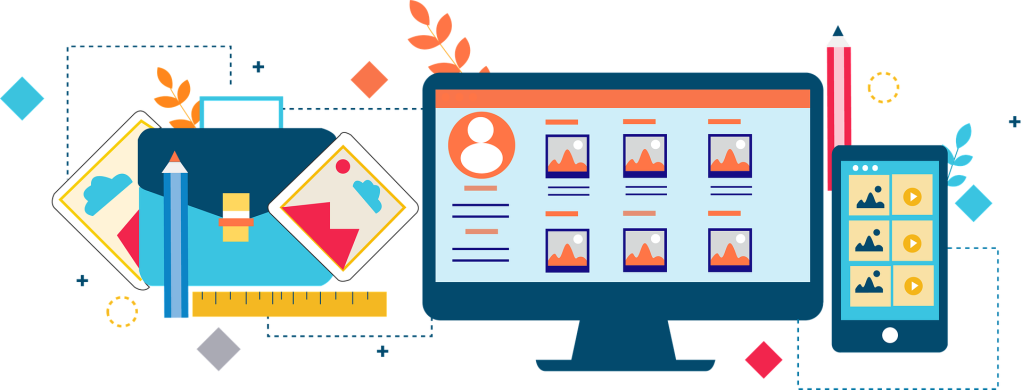
According to What is an ePortfolio, the “minimalist definition of an ePortfolio [is] a learner’s digital evidence of meaningful connections.”
- The first course of the ADL program was the Innovation Course.
- The second course is the ePortfolio course; the following are insights into my ePortfolio development.
Opting out of the accelerated program permitted me to submit the Innovation course requirements through Google Docs. This ePortfolio course provides time for creativity and content development. Therefore, my initial focus was on incorporating the revisions recommended through the feedforward received on the innovation compilation. Revising out-of-date web design practices to remove all the click-here references for links and course numbers or title references.
The next step was to create a blog section and connect it to the ePortfolio, an elusive feat in the first course. Once completed, there were two pages but no clear direction for further content development. While reviewing the invitation to innovate advising to decide where to focus initial development efforts, the page confused the focus and intended audience as a homepage. While the invitation was for advising colleagues, they were not the primary goal of this ePortfolio resource.
Since most prior learning experiences followed the sit-and-get model, and collecting the dots had become an ingrained study habit, I started by focusing on the course modules, clinging desperately to these shared websites, readings, and discussions for the checklist, and falling down the rabbit trail. A fill-in-the-blank approach to reflection would not work for an authentic learning experience. I had to unlearn the habit of looking for the instructor’s expectations. It was helpful to learn that seeking a checklist-type learning experience would mean missing out on actual learning, as pointed out by Dr. Harapnuik with support from “people like John Dewey and Jean Piaget” (Harapnuik et al., 2018, p. 35).
I sought to find my voice through class meetings, break-out sessions, discussion posts, learning community meetings, and blogging. Sharing through the bio and advising philosophy provided personal touches to give the reader a sense of me, my voice, and my why. Evaluating how using an ePortfolo would benefit personally/professionally and addressing personal insecurities were necessary to start putting learning reflections online.
Additional evaluation of the ADL Program would allow for backward design ideas for form, function, and the aesthetic of the ePortfolio. Class discussions often included encouragement for an effective navigation structure. One evening, I was able to experience the benefits of the portability of an ePortfolio because the Blackboard/Learning Management Software (LMS) would not log in. Searching harapnuik.org, I could still reflect on who owns the ePortfolio. As a result of this experience, I finally understood why an LMS would have limited my innovation proposal.
Getting deeper into the COVA book, I began to process the role of choice, ownership, and voice through authentic learning opportunities while reflecting on this ePortfolio. I struggled to make my ePortfolio real and to find my voice. While reviewing examples of ePortfolios, I saw different learning environments, innovations, and individual creative expressions through the ePortfolio exploration.
In addition to the weekly readings and videos, I supplemented content by watching Learner’s Mindset Discussions. Through these discussions, I realized I had not yet taken ownership. I thought I was battling to find my voice and the line where I would feel comfortable sharing my vulnerable learning with my professional community. Instead, I realized I had to flesh out what my advising resource would include. I needed to start making my ePortfolio work for me. I remembered this ePortfolio could help with day-to-day informational interactions, enabling the relationship-building needed between advisor and advisee. I began by creating informational pages from commonly answered questions. I made logical connections to additional information that would benefit students, and the content flowed easily. Within days, long and overwhelming emails become shorter emails with embedded links. After creating a few pages, it was confirmed that a well-developed navigation structure would help the reader locate relevant information. As content grew, the navigation structure was expanded and refined. I fully embrace this authentic learning opportunity, linking pages, adding categories and a search feature, reevaluating naming conventions, and, most importantly, using this ePortfolio and applying the growth mindset to daily life.
These final weeks of the ePortfolio course were the most significant learning shift. While reviewing classmates’ ePortfolios, I am so proud to see what everyone is creating. I realized I could have missed the opportunity to grow with them if I got stuck in a crisis of self. I imagined how much our cohort would continue to grow, affect their learners, and change the world. I spent days reviewing and giving bona fide observations to classmates with the hopes of helping them improve their ePortfolios. Now, I truly understand the importance of feedback within a trusted relationship and recognize the benefits of true feedforward. While compliments feel good, they do not contribute to actual improvements.
Looking to the future of my ePortfolio, I intend to continue to add content and refine the navigation as my site continues to grow. I am getting personal about my learning and looking forward to helping my students develop their growth mindsets as I learn about my own.
I am adding and adjusting things almost daily on my ePortfolio. Now that my ePortfolio has become a daily part of my professional life, it will continue to grow and evolve, just as I am.
Harapnuik, D. (2021, May). What is an ePortfolio. Harapnuik.org. Retrieved from https://www.harapnuik.org/?page_id=5977
Harapnuik, D., Thibodeaux, T., & Cummings, C. (2018). Choice, Ownership, and Voice through Authentic Learning. Creative Common License.
